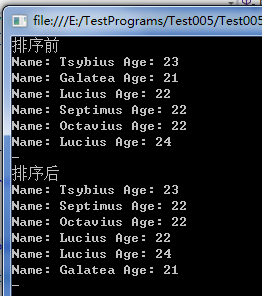说明(2017-7-17 21:34:59):
原文:https://my.oschina.net/Tsybius2014/blog/298702?p=1
另一篇比较好的:https://wenku.baidu.com/view/b53cd250ad02de80d4d84073.html
摘要: C# 使用IComparer自定义List类的排序方案
List类中不带参数的Sort函数可以用来为List类中的元素排序,但如果List类中的元素类型本身不能直接进行比较(如自定义的struct和很多class),或是希望采用更加灵活的自定义比较方式,可以通过继承了IComparer接口的函数来解决。
代码示例如下:
1)声明一个类
/// <summary>
/// 人物类
/// </summary>
public class Person
{
public string Name;
public int Age;
public override string ToString()
{
return "Name: " + Name + " Age: " + Age;
}
}2)声明一个继承了接口IComparer的类
/// <summary>
/// 比较人物类实例大小,实现接口IComparer
/// </summary>
public class PersonComparer : IComparer<Person>
{
public int Compare(Person x, Person y)
{
if (x == null && y == null) return 0;
if (x == null) return -1;
if (y == null) return 1;
//TODO:Person类实例X与Y的比较规则
//按姓名由小到大排列,姓名相同的人年龄大的在前
{
int temp = string.Compare(x.Name, y.Name);
if (temp > 0) return -1;
else if (temp < 0) return 1;
if (x.Age > y.Age) return 1;
if (x.Age < y.Age) return -1;
}
return 0;
}
}3)Main函数,建立一个List,并使用刚建立的PersonComparer类中的规则对List进行排序
static void Main(string[] args)
{
List<Person> a = new List<Person>();
a.Add(new Person() { Name = "Tsybius", Age = 23 });
a.Add(new Person() { Name = "Galatea", Age = 21 });
a.Add(new Person() { Name = "Lucius", Age = 22 });
a.Add(new Person() { Name = "Septimus", Age = 22 });
a.Add(new Person() { Name = "Octavius", Age = 22 });
a.Add(new Person() { Name = "Lucius", Age = 24 });
//输出a中全部元素
Console.WriteLine("排序前");
foreach (var v in a)
{
Console.WriteLine(v.ToString());
}
Console.WriteLine("-");
//对a进行排序
a.Sort(new PersonComparer());
//输出a中全部元素
Console.WriteLine("排序后");
foreach (var v in a)
{
Console.WriteLine(v.ToString());
}
Console.WriteLine("-");
Console.ReadLine();
}4)程序运行示例

END